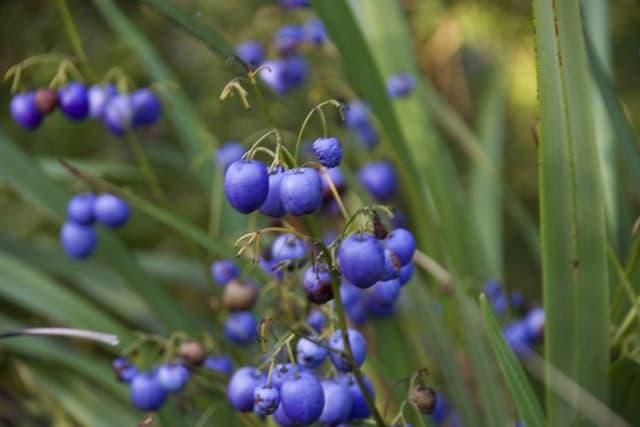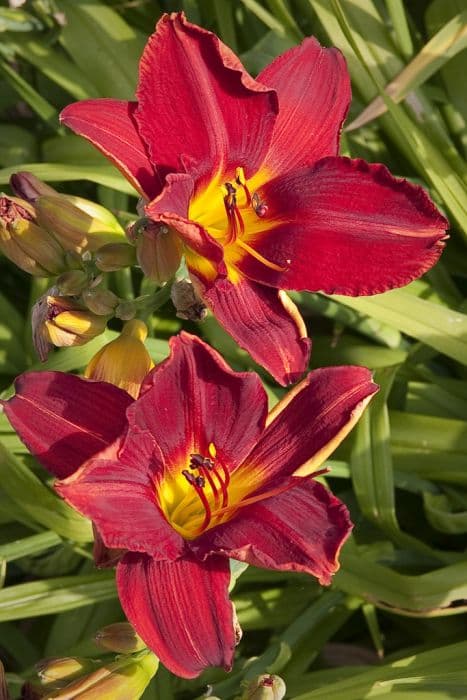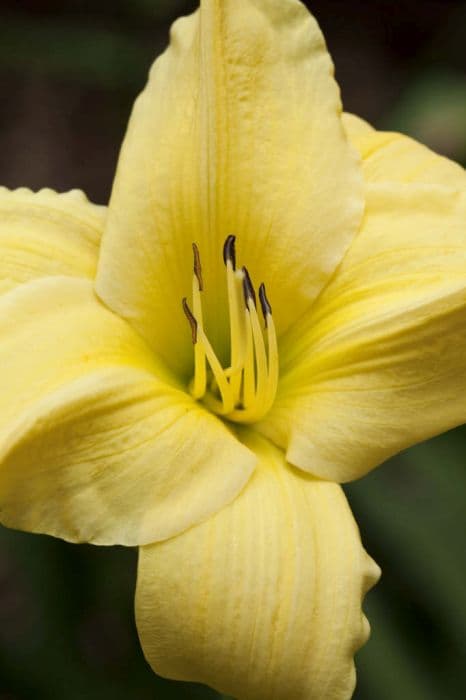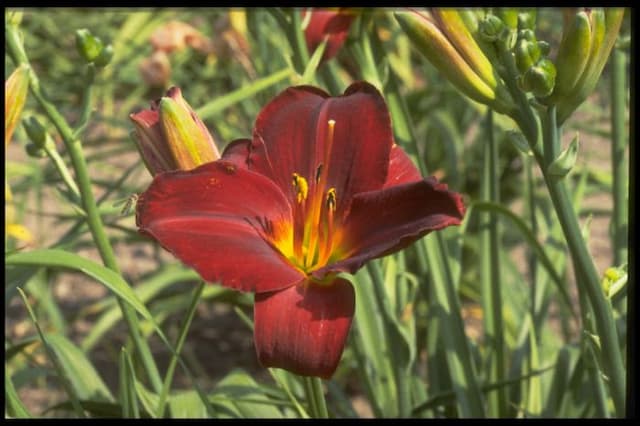Daylily Hemerocallis 'Marion Vaughn'

ABOUT
The Hemerocallis 'Marion Vaughn', commonly known as the Daylily, is notable for its striking flower features and foliage. The plant bears large, trumpet-shaped blooms that display a delicate color palette. Each flower exhibits a soft cream to pale yellow base, often accentuated by a subtle throat in a contrasting hue, which adds depth and allure to the overall appearance. The petals may be gently ruffled along the edges, contributing a touch of elegance to the flowers. These blossoms stand out gracefully against a backdrop of long, slender leaves that arch gracefully from the base of the plant. The leaves themselves possess a rich green color, which forms a lush, strap-like foliage clump that adds texture to the garden throughout the growing season. While the Daylily is a perennial favorite in many gardens, it is specifically the 'Marion Vaughn' cultivar that is celebrated for its unique flower coloration and reliable blooming habit. Each individual flower typically lasts for just one day, yet the plant produces numerous buds that open in succession, ensuring a long-lasting floral display that can be appreciated over an extended period during its bloom time.
About this plant
 Names
NamesFamily
Asphodelaceae
Synonyms
Daylily
Common names
Hemerocallis 'Marion Vaughn'.
 Toxicity
ToxicityTo humans
The plant commonly known as daylily is not considered toxic to humans. In fact, certain varieties of daylilies are known to be edible and are sometimes used in culinary dishes, particularly in Asian cuisine. It is important, however, to be certain of the species and that it is indeed a daylily as there are many look-alike plants that are toxic. Generally, ingesting daylilies does not cause poisoning in humans. However, individual allergies or sensitivities can happen with any plant.
To pets
The plant commonly known as daylily is toxic to cats and can cause severe kidney damage if ingested. Symptoms of daylily poisoning in pets, especially cats, may include vomiting, lethargy, kidney failure, and lack of appetite. If you suspect your pet has ingested daylilies, it is important to seek veterinary care immediately, as the consequences can be life-threatening. Dogs are typically less sensitive to daylilies, but it is still advisable to prevent dogs from ingesting the plant as it can potentially cause gastrointestinal upset.
 Characteristics
CharacteristicsLife cycle
Perennials
Foliage type
Deciduous
Color of leaves
Green
Flower color
Yellow
Height
2 feet [60 cm]
Spread
2 feet [60 cm]
Plant type
Herb
Hardiness zones
3
Native area
Asia
Benefits
 General Benefits
General Benefits- Attractive Flowers: Hemerocallis 'Marion Vaughn', commonly known as Daylily, has beautiful blooms that add aesthetic value to any garden.
- Low Maintenance: Daylilies require minimal care and can thrive in a variety of soil conditions and climates.
- Drought Tolerance: These plants are known for their ability to withstand dry periods, making them ideal for water-conservation landscaping.
- Pest Resistance: Many daylily varieties, including 'Marion Vaughn', are resistant to pests, reducing the need for chemical treatments.
- Rapid Growth: Daylilies can establish themselves and spread quickly, effectively filling garden spaces.
- Propagates Easily: They can be easily propagated by division, allowing gardeners to multiply their plants and cover more area.
- Edible Parts: Some parts of daylilies are edible, with flowers being used in certain culinary applications (although the 'Marion Vaughn' is not specifically known for this benefit).
- Versatile Landscaping: Daylilies can be used in borders, beds, and as ground cover, adding versatility to garden design.
- Long Blooming Period: These plants have a long flowering season, which ensures that the garden remains colorful for an extended period.
- Tolerant of Various Lighting Conditions: They can grow in full sun to partial shade, accommodating different garden exposures.
 Medical Properties
Medical PropertiesThis plant is not used for medical purposes.
 Air-purifying Qualities
Air-purifying QualitiesThis plant is not specifically known for air purifying qualities.
 Other Uses
Other Uses- Daylilies like 'Marion Vaughn' can be used as natural pest control in gardens because some pests prefer to eat daylilies over other plants, potentially protecting more valuable crops.
- The sturdy foliage of daylilies can provide support for weaker-stemmed plants in the garden, offering a natural trellising effect.
- Daylilies can be planted on slopes or banks to help prevent soil erosion due to their extensive root system that holds soil in place.
- The flowers of the daylily can be used as a natural dye source for fabrics, yielding a variety of colors depending on the mordant used.
- Dried daylily petals can be incorporated into homemade potpourri mixtures to add color and a subtle floral scent to a room.
- Daylily blooms are edible and can be used to garnish salads or desserts for an elegant touch in culinary presentation.
- As a companion plant, daylilies can help in the garden by attracting pollinators such as bees and butterflies to crops that require pollination.
- Daylilies can be used in large-scale landscaping projects to quickly cover ground, as they multiply rapidly and are relatively low maintenance.
- During blooming season, daylilies provide cut flowers for indoor arrangements, as they have a vase life of a few days per flower.
- The thick roots of daylilies can be used in the practice of hugelkultur, a permaculture method that involves creating mounds of woody debris and soil for growing plants.
Interesting Facts
 Feng Shui
Feng ShuiThe Daylily is not used in Feng Shui practice.
 Zodiac Sign Compitability
Zodiac Sign CompitabilityThe Daylily is not used in astrology practice.
 Plant Symbolism
Plant Symbolism- Daylily (Hemerocallis 'Marion Vaughn'):
- Beauty: Known for their striking appearance and various colors.
- Mothers: In Chinese culture, daylilies symbolize motherhood and nurturing due to the plant's ability to produce numerous flowers.
- Transience: The name 'Hemerocallis' is derived from Greek words meaning "beauty" and "day," as most daylily flowers last for only a day, symbolizing the transient nature of life.
- Renewal and Hope: Each new bloom represents fresh chances and hope for new opportunities.
 Water
WaterDaylilies, such as the Hemerocallis 'Marion Vaughn', should be watered deeply once a week, providing about one inch of water each time. During hot or dry weather, increase watering to twice a week. Ensure the water reaches the roots by using a soaker hose or drip irrigation for best results, allowing the moisture to penetrate deeply into the soil. Avoid overhead watering to minimize the risk of leaf diseases. Daylilies can tolerate short dry spells, but consistent watering will promote lush foliage and vibrant blooms.
 Light
LightDaylilies, including Hemerocallis 'Marion Vaughn', thrive in full sun to partial shade. They perform best when they receive at least six hours of direct sunlight daily. An ideal spot for them would be an area that gets bright morning light and some afternoon shade, especially in hotter climates, to prevent the blooms from fading quickly.
 Temperature
TemperatureDaylilies, such as the Hemerocallis 'Marion Vaughn', are tolerant of a wide range of temperatures. They can survive winter temperatures down to about -20°F and summer temperatures well above 90°F. The ideal growing temperatures for daylilies are between 60°F and 75°F. These conditions will encourage the plant to produce vigorous growth and abundant flowers.
 Pruning
PruningDaylilies, such as Hemerocallis 'Marion Vaughn', should be pruned to remove spent flower stalks and to deadhead faded blooms, which encourages the plant to produce more flowers. The best time to prune is after a bloom cycle is complete. Cut back the foliage to the ground in late fall or early winter to tidy up the plant and help control pests and diseases.
 Cleaning
CleaningAs needed
 Soil
SoilDaylilies thrive in well-draining soil enriched with organic matter. A good soil mix for daylilies could be one part loam, one part peat moss or compost, and one part perlite or sand to ensure proper drainage. The pH should be slightly acidic to neutral, ranging from 6.0 to 7.0, for optimal growth and flower production.
 Repotting
RepottingDaylilies, including 'Marion Vaughn', rarely require repotting as they are typically grown outdoors in the ground. However, if grown in containers, they should be repotted every 2-3 years or when they outgrow their current pot, usually when root-bound or the soil is depleted.
 Humidity & Misting
Humidity & MistingDaylilies are adaptable to a wide range of humidity conditions and do not have specific humidity requirements. They perform well in the varying humidity levels commonly found in outdoor garden environments.
 Suitable locations
Suitable locationsIndoor
Place daylilies by a sunny window, and keep the soil moist.
Outdoor
Ensure full sun to part shade and well-drained soil for healthiest growth.
Hardiness zone
3-9 USDA
 Life cycle
Life cycleThe Daylily 'Marion Vaughn' begins its life cycle when the seed germinates, establishing a root system and sprouting initial foliage. As it matures into a vegetative state, foliage expands and the plant develops a clump of strap-like leaves. Throughout the growth period, rhizomatous roots expand, creating a larger clump. After reaching maturity, the daylily produces tall scapes which bear numerous buds that eventually bloom into distinctive, typically yellow flowers, usually in early to mid-summer. Each individual flower lasts only one day, but multiple buds ensure a prolonged blooming period. As the blooming season ends, seeds develop in pods at the spent flower site; if not deadheaded, these seeds can disperse, beginning a new cycle, while the parent plant goes dormant in winter to re-emerge in spring.
 Propogation
PropogationPropogation time
Late Summer to Early Fall
The Hemerocallis 'Marion Vaughn', commonly known as the Daylily, is typically propagated through division, which is the most popular method. Division is best done in the early spring or immediately after flowering has ceased in late summer or early fall. To propagate by division, one should carefully lift the entire plant out of the ground with a garden fork, being mindful to minimize root damage. The clumps of daylilies can then be gently pulled apart by hand or with the aid of a garden knife, ensuring that each division has at least one fan of leaves and a portion of the root system. These divisions should be immediately replanted at the same depth they were growing initially and watered thoroughly, with spacing between 18 to 24 inches (approximately 45 to 60 centimeters) to allow for sufficient room for growth.









